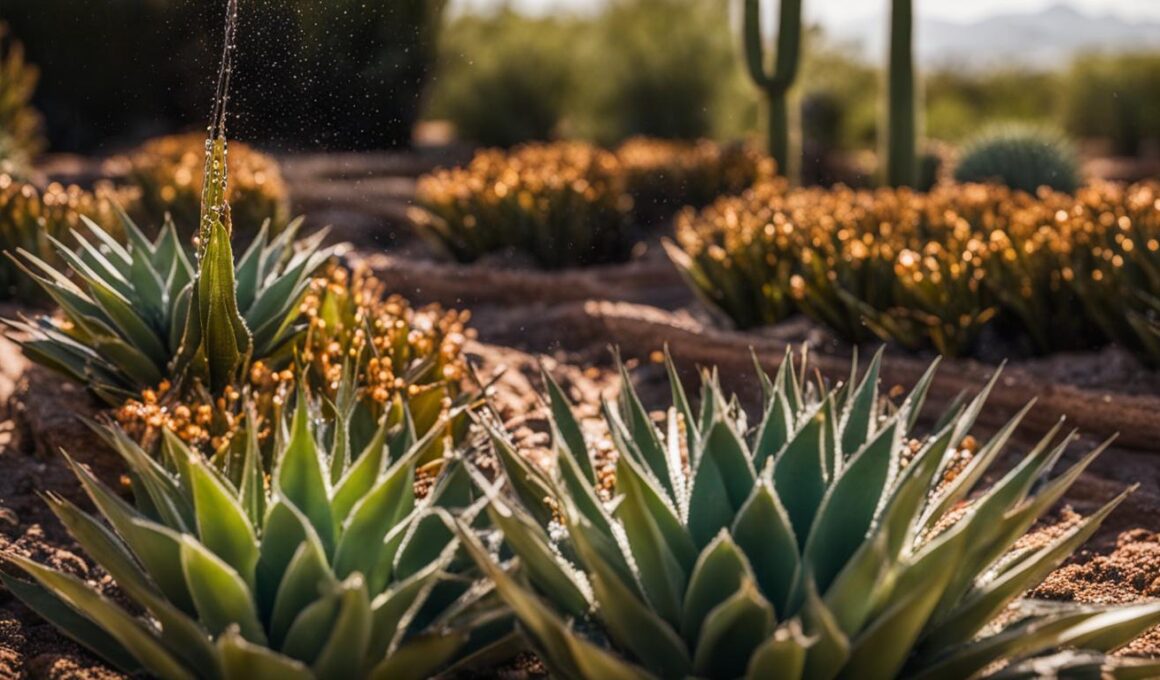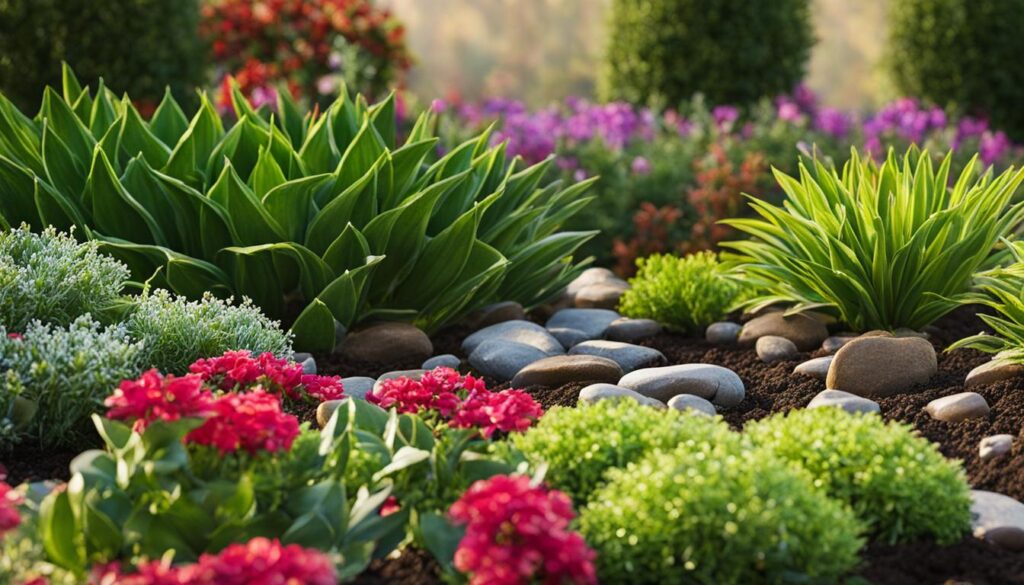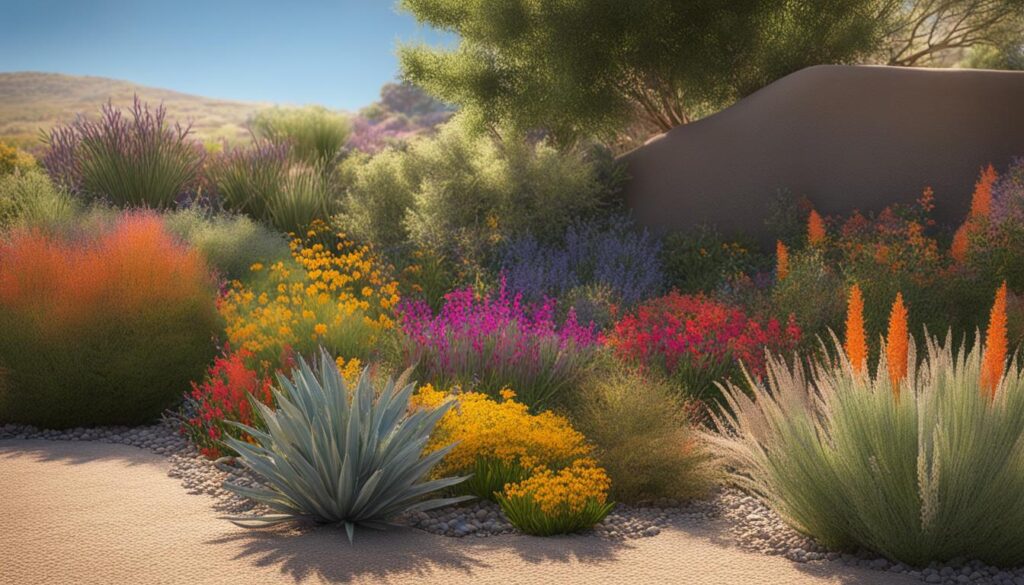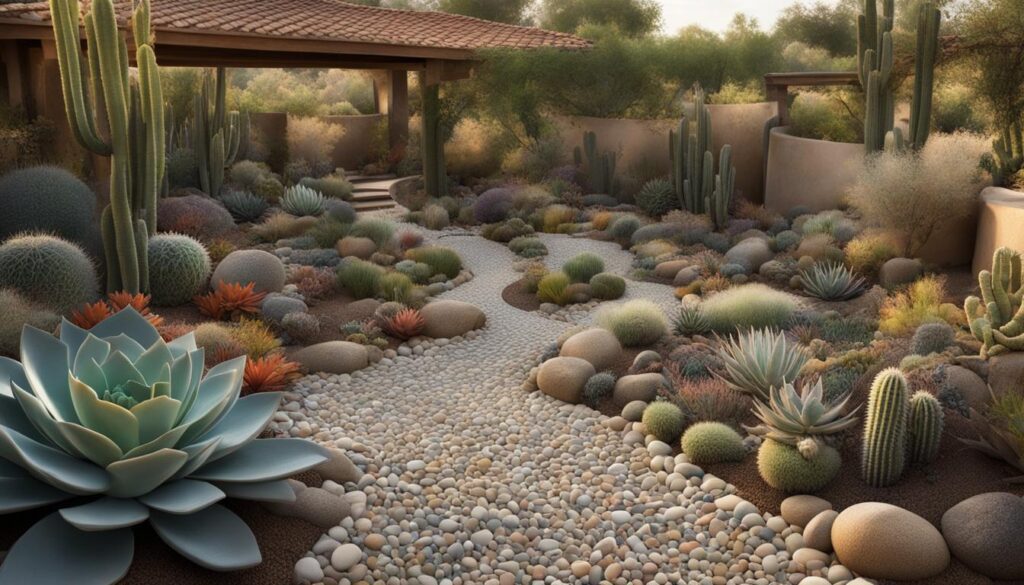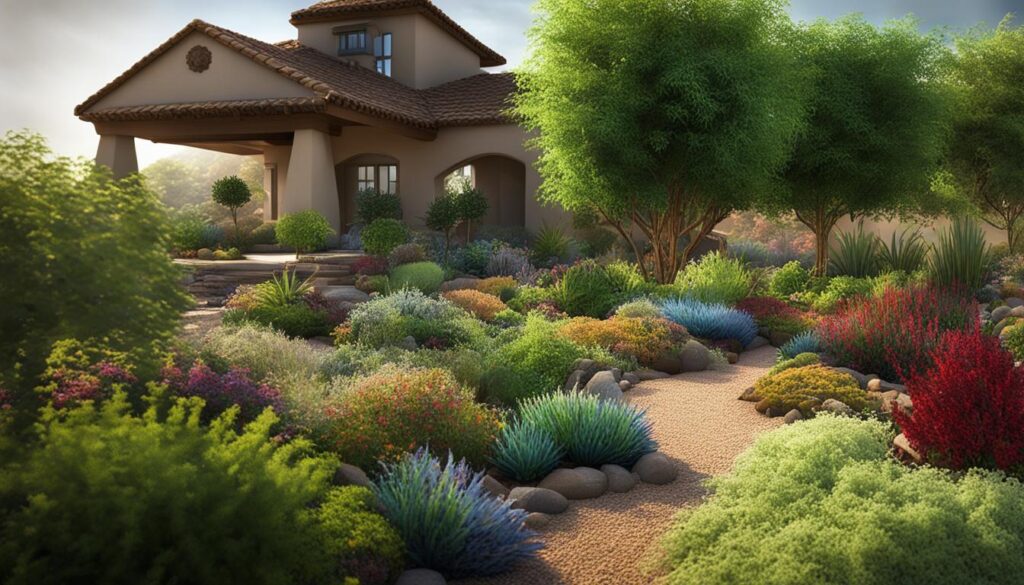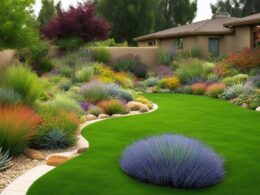Welcome to our article on the benefits of drip irrigation in xeriscaping. If you’re looking to improve water efficiency, plant health, and lower your gardening bills, then drip irrigation is the solution for you. Xeriscaping, a landscaping technique that focuses on water conservation, can greatly benefit from the use of drip irrigation systems.
Drip irrigation is highly recommended by professional landscapers in 90% of landscapes. Unlike other irrigation options like hand watering or sprinkler systems, drip irrigation provides the right amount of water at the right times. It is the most efficient method for watering xeriscapes and can even be connected to rainwater harvesting systems for even greater sustainability.
By installing a drip irrigation system, you can train the roots of your plants to grow deep into the soil. This promotes plant health and reduces the need for frequent watering. Additionally, drip irrigation helps lower gardening bills by conserving water and reducing the reliance on manual labor.
Key Takeaways:
- Drip irrigation is recommended by professionals for 90% of landscapes.
- Xeriscaping relies on thorough, regular watering during the first two summers.
- Drip irrigation provides the right amount of water at the right times.
- Drip irrigation can be connected to rainwater harvesting systems for greater sustainability.
- By promoting deep root growth, drip irrigation enhances plant health and reduces the need for frequent watering.
Types of Irrigation in Xeriscaping
When it comes to irrigating your xeriscape, there are various options to consider. Each method has its benefits and drawbacks, so it’s important to choose the one that suits your specific needs and landscape. Here are the different types of irrigation commonly used in xeriscaping:
1. Hand Watering
Hand watering involves manually watering your plants using a hose, watering can, or bucket. This method is effective for landscapes with exceptionally drought-tolerant plants that require minimal watering. It gives you full control over the amount of water each plant receives, but it can be time-consuming, especially for larger landscapes.
2. Sprinkler Systems
Sprinkler systems are a popular choice for many homeowners due to their convenience. However, they are not the most efficient option for xeriscaping. Sprinklers tend to waste water through evaporation and runoff, resulting in less water reaching the plants’ roots. They are best suited for lawns and larger areas with high water requirements.
3. Point Source Drip Irrigation
This method involves providing each individual plant with one or two emitters at the base. Point source drip irrigation delivers water directly to the root zone, minimizing water loss through evaporation and ensuring efficient water distribution. It’s ideal for landscapes with a variety of plant types and different water requirements.
4. Drip Irrigation on a Grid
Drip irrigation on a grid provides full ground coverage over the entire planting bed. It consists of flexible tubes with emitters laid on top of the soil and covered with mulch. This method ensures even water distribution and maximizes water efficiency. It’s the most common and recommended form of irrigation for xeriscaping.
When choosing the right irrigation method for your xeriscape, consider factors such as plant type, soil, climate, and schedule. Each method has its own advantages and disadvantages, so it’s important to weigh them against your specific needs and goals.
Benefits of Drip Irrigation in Xeriscaping
Drip irrigation is the best way to water a xeriscape as it provides the right amount of water at the right times. This irrigation method consists of flexible tubes with emitters laid on top of the soil and covered with mulch, ensuring efficient water delivery directly to the root zone of plants. The use of drip irrigation in xeriscaping offers numerous benefits for water efficiency, plant health, and lower gardening bills.
One key advantage of drip irrigation is its water efficiency. Unlike traditional sprinkler systems, which can result in significant water wastage due to evaporation or runoff, drip irrigation delivers water directly to the plant’s root system, minimizing water loss. This targeted watering approach ensures that each plant receives the precise amount of water it needs, reducing water consumption and promoting water conservation.
Using drip irrigation can lead to water savings of up to 50% compared to conventional irrigation methods[1].
In addition to water efficiency, drip irrigation also promotes plant health. By providing water directly to the root zone, it encourages deep root growth, resulting in stronger and more resilient plants. Deep roots enable plants to access moisture stored deeper in the soil, making them better equipped to withstand drought conditions. The controlled and consistent moisture levels from drip irrigation help prevent overwatering and reduce the risk of plant diseases caused by excess moisture.
Furthermore, drip irrigation can contribute to lower gardening bills. By using water more efficiently and avoiding wastage, homeowners can see a significant reduction in their water bills. Additionally, the targeted watering approach of drip irrigation minimizes the need for frequent manual watering, saving time and effort. With lower water consumption and reduced maintenance requirements, homeowners can enjoy cost savings while still maintaining a healthy and vibrant xeriscape.
| Benefits of Drip Irrigation in Xeriscaping |
|---|
| Water efficiency |
| Promotes plant health |
| Lower gardening bills |
Table: Benefits of Drip Irrigation in Xeriscaping
Overall, drip irrigation is an essential component of a successful xeriscape. Its water-saving capabilities, promotion of plant health, and cost-effectiveness make it the preferred choice for efficient irrigation in water-wise landscaping. By implementing drip irrigation in your xeriscape, you can achieve beautiful and thriving gardens while minimizing water usage and reducing gardening expenses.
References:
- “Water Efficiency in the Yard and Garden.” University of California Agriculture and Natural Resources. https://ucanr.edu/sites/UrbanHort/Water_Use_of_Pacific_Northwest_Landscapes/Chapter_2__Water_Efficiency_in_the_Yard_and_Garden/#4_2
Xeriscaping in Desert Landscapes
When it comes to xeriscaping in desert landscapes, special considerations need to be taken into account. With the scarcity of water in these regions, it’s crucial to implement strategies that maximize water efficiency while still promoting healthy plant growth. Two key techniques for xeriscaping in desert landscapes are grading and contouring the soil and creating rain gardens.
Grading and contouring the soil is a method used to guide naturally-occurring moisture to where it’s most needed, typically trees and shrubs with deeper root systems. By shaping the terrain, water is directed towards these plants, reducing the need for supplemental irrigation. This technique takes advantage of the seasonal rains and encourages plant growth with minimal water input.
Rain gardens are another effective strategy for xeriscaping in desert landscapes. In regions with occasional rainfall, creating depressions or sunken areas in the landscape allows water to collect and be absorbed by plants. These gardens are designed to capture and retain rainwater, promoting deep root systems and reducing the reliance on irrigation systems.
Drought-Tolerant Plants for Desert Xeriscapes
When selecting plants for xeriscaping in desert landscapes, it’s essential to choose species that are well-adapted to arid conditions. Drought-tolerant plants are able to thrive with minimal water, making them ideal for xeriscapes. Examples of drought-tolerant plants suitable for desert xeriscapes include:
- Agave
- Yucca
- Desert Marigold
- Red Yucca
- Desert Spoon
- Creosote Bush
These plants have evolved to withstand the harsh conditions of desert landscapes, making them resilient and low-maintenance choices for xeriscaping projects.
| Plant | Sun Exposure | Water Needs | Height |
|---|---|---|---|
| Agave | Full Sun | Low | 2-6 feet |
| Yucca | Full Sun | Low | 3-8 feet |
| Desert Marigold | Full Sun | Low | 1-2 feet |
| Red Yucca | Full Sun | Low | 3-4 feet |
| Desert Spoon | Full Sun | Low | 2-4 feet |
| Creosote Bush | Full Sun | Low | 3-5 feet |
Watering Guidelines for Xeriscapes
Proper watering is essential for the success of your xeriscape. By following these watering guidelines, you can ensure that your plants receive the right amount of water and thrive in their water-efficient landscape.
1. Deep Watering
Deep watering is crucial for promoting deep root growth and drought tolerance in your plants. Instead of frequent shallow waterings, which can encourage shallow root systems and make plants more susceptible to drought, aim for deep, thorough soakings. This helps the roots grow deeper into the soil, allowing them to access moisture more effectively.
2. Infrequent Watering
While deep watering is important, it’s equally essential to water infrequently. Xeriscapes are designed to be low-water landscapes, so watering too often can lead to excessive moisture and potential issues like root rot or plant diseases. Instead, allow the soil to dry out between waterings. This encourages plants to develop stronger, more resilient root systems.
3. Adjust Based on Needs
The specific water needs of your xeriscape will depend on various factors such as the plant selection, soil type, climate, and recent weather conditions. Pay attention to signs of water stress like wilted leaves or dry soil, and adjust your watering schedule accordingly. Monitoring your landscape’s moisture levels and responding accordingly can help you strike the right balance for optimal plant health.
To summarize, deep and infrequent watering are the key principles to remember when watering your xeriscape. By promoting deep root growth and allowing the soil to dry out between waterings, you can create a water-efficient landscape that thrives with minimal water input.
| Watering Guidelines for Xeriscapes | Key Points |
|---|---|
| Deep Watering | Promotes deep root growth and drought tolerance |
| Infrequent Watering | Avoid excessive moisture and encourage resilient root systems |
| Adjust Based on Needs | Monitor signs of water stress and adjust watering accordingly |
Xeriscape Benefits Beyond Water Conservation
While water conservation is a significant advantage of xeriscaping, there are other benefits that make it a desirable landscaping choice. Xeriscapes can increase property value by up to 14%, making it a sound investment for homeowners. Additionally, many local governments offer financial incentives and rebates for xeriscaping projects, further enhancing its appeal.
In terms of maintenance, xeriscapes are time-saving. With less watering, mowing, and weeding required, homeowners can spend more time enjoying their outdoor spaces rather than tending to them. Xeriscaping also promotes biodiversity by providing habitat for native animals and insects, supporting the local ecosystem.
“Xeriscaping not only conserves water but also saves time, money, and supports biodiversity,” says Jane Smith, a landscape architect with over 20 years of experience. “It’s a win-win situation for homeowners and the environment.”
Biodiversity in Xeriscapes
Xeriscapes promote biodiversity by incorporating native plants that are well-suited to the local climate and soil conditions. These plants attract a variety of native wildlife, such as birds, butterflies, and bees. By providing food, shelter, and nesting sites, xeriscapes contribute to the overall health and diversity of the ecosystem.
In contrast, traditional lawns and landscaping often rely on non-native plants that require more water, fertilizer, and pesticides to thrive. This reliance on chemicals and excessive water usage can harm the environment and disrupt natural habitats. Xeriscaping offers a sustainable alternative that supports local ecosystems and preserves natural resources.
| Benefits of Xeriscaping Beyond Water Conservation | |
|---|---|
| Increased property value | Up to 14% |
| Financial incentives | Local government rebates |
| Time-saving | Less maintenance required |
| Biodiversity support | Habitat for native wildlife |
Design Principles of Xeriscaping
When planning and designing your xeriscape, there are several key principles to consider to ensure a successful and sustainable landscape.
Proper Planning and Design
The first step in creating a xeriscape is to carefully plan and design your landscape. Assess the natural features of your yard, such as sun exposure, soil type, and drainage. Consider the functional areas you desire, such as outdoor seating or entertaining spaces. Create a blueprint or sketch to visualize your design and allocate space for different elements, including plants, pathways, and focal points.
Soil Improvements
Before planting, it’s essential to improve the quality of your soil. Conduct a soil test to determine its composition and nutrient levels. Based on the results, amend the soil with organic matter, such as compost or aged manure, to improve its structure and fertility. This will enhance water retention, promote root growth, and provide a healthy foundation for your plants.
Efficient Irrigation
One of the main goals of xeriscaping is to use water efficiently. Installing a drip irrigation system is highly recommended, as it delivers water directly to the root zone of plants, minimizing evaporation and runoff. Set up zones based on plant water needs and adjust the system accordingly. By using efficient irrigation techniques, you can reduce water waste and ensure that each plant receives the appropriate amount of water.
Limited Turf Use
Xeriscaping emphasizes minimizing the use of turfgrass, which requires a significant amount of water to maintain. Instead, consider incorporating elements such as native groundcovers, low-maintenance shrubs, or decorative gravel in areas where turfgrass is not necessary. This not only conserves water but also reduces maintenance efforts and allows for more diverse plantings.
Mulching
Applying mulch to your xeriscape has multiple benefits. It helps retain moisture in the soil, reducing the frequency of watering. Mulch also regulates soil temperature, prevents weed growth, and adds an aesthetic appeal to your landscape. Use organic materials, such as wood chips or shredded bark, and apply a layer about 2-3 inches thick around plants, leaving space around the stem to avoid rot.
Drought-Tolerant Plants
Choose plants that are well-suited to your local climate and require minimal water once established. Native plants are an excellent choice as they are naturally adapted to the region’s conditions. Look for species that have low water requirements and can withstand periods of drought. By selecting drought-tolerant plants, you can reduce the need for supplemental watering and create a resilient, water-wise landscape.
Maintenance
Regular maintenance is crucial to keep your xeriscape looking its best. This includes pruning plants as needed, removing weeds, monitoring irrigation systems for leaks or clogs, and adjusting watering schedules based on seasonal changes. Stay vigilant in providing appropriate care to your xeriscape, and it will continue to thrive and provide long-term benefits.
By incorporating these design principles into your xeriscape, you can create a visually appealing and water-efficient landscape that thrives with minimal maintenance. With proper planning, efficient irrigation, and the use of drought-tolerant plants, you can enjoy a beautiful outdoor space while conserving water and supporting the environment.
Benefits of Xeriscaping for Your Wallet and the Environment
Xeriscaping offers a range of benefits for both your wallet and the environment. By implementing water-conserving strategies and making smart choices in your landscape design, you can save money on your water bills, attract buyers if you decide to sell your property, and contribute to the preservation of our natural resources.
Water Conservation and Money-Saving
Xeriscaping is an excellent way to conserve water and reduce your water bills. By using efficient irrigation systems like drip irrigation, which delivers water directly to the roots of plants, you can minimize water waste and ensure that every drop is used effectively. Drip irrigation systems can be connected to rainwater harvesting systems, further reducing your reliance on municipal water sources.
Additionally, xeriscaping eliminates the need for excessive watering, as the chosen plants are drought-tolerant and adapted to your local climate. This means less time spent watering and more money saved on your gardening bills.
Financial Incentives and Attracting Buyers
Many local governments offer financial incentives for homeowners who choose to xeriscape their landscapes. These incentives can include rebates, grants, or tax credits, which can help offset the initial costs of xeriscaping. By taking advantage of these incentives, you can save even more money while creating a beautiful and environmentally friendly landscape.
In addition to financial incentives, xeriscaping can also increase the value of your property. Buyers are increasingly attracted to water-efficient homes and landscapes, recognizing the long-term benefits and cost savings associated with xeriscaping. A well-designed xeriscape can make your property stand out in the real estate market and potentially fetch a higher selling price.
Time-Saving, Biodiversity, and Pollution Reduction
One of the often-overlooked benefits of xeriscaping is the time it saves on maintenance. With xeriscaping, you can say goodbye to frequent mowing, excessive pruning, and constant weeding. The selected plant species are carefully chosen for their adaptability to your local environment, reducing the need for time-consuming maintenance tasks.
Xeriscaping also promotes biodiversity by using native plant species that provide habitats and food sources for local wildlife. By creating a diverse and sustainable ecosystem in your yard, you contribute to the preservation of biodiversity in your community.
Furthermore, xeriscaping helps reduce pollution by minimizing or eliminating the use of pesticides, herbicides, and synthetic fertilizers. By embracing organic gardening practices and choosing plants that are naturally resistant to pests and diseases, you create a healthier environment for yourself, your family, and the surrounding ecosystem.
| Benefits of Xeriscaping | Wallet | Environment |
|---|---|---|
| Water Conservation | Saves money on water bills | Preserves water resources |
| Financial Incentives | Rebates, grants, tax credits | Encourages sustainable practices |
| Attracting Buyers | Increases property value | Reduces water consumption |
| Time-Saving | Less maintenance required | Promotes biodiversity |
| Biodiversity | Provides habitats for wildlife | |
| Pollution Reduction | Minimizes the use of chemicals |
Considerations Before Xeriscaping Your Lawn
Before embarking on the journey of xeriscaping your lawn, there are a few important considerations to keep in mind. While xeriscaping offers numerous benefits such as water conservation and lower maintenance, it may also have some implications that you should be aware of. Take the time to evaluate these factors to ensure that xeriscaping is the right choice for your outdoor space.
Reduced Turfgrass Area
One of the considerations when xeriscaping your lawn is the reduction in turfgrass area. Xeriscaping often involves replacing portions of your lawn with drought-tolerant plants, ground covers, or hardscape features. This may limit the amount of space available for outdoor activities such as playing sports or having picnics. Before committing to xeriscaping, assess your needs for a functional turfgrass area and determine how much space you are willing to allocate for it.
Cost and Installation
Another factor to consider is the cost and installation process of xeriscaping. While xeriscaping can save you money in the long run by reducing water bills and maintenance expenses, there may be initial costs involved. These costs can vary depending on factors such as the size of your lawn, the materials used, and whether you choose to hire professionals or do it yourself. Research and budget accordingly to ensure that you are prepared for the upfront investment.
Clean Up
Cleaning up leaves, debris, and other organic matter on a xeriscaped lawn may require additional tools or methods compared to traditional turfgrass lawns. In rocky areas, leaves and debris can accumulate between rocks and may require extra effort to clear. Consider the level of maintenance and clean-up required for your xeriscaped landscape and if you have the necessary tools and time to maintain it properly.
Noise Reduction and Cooling Effects
Turfgrass lawns have been known to provide noise reduction and cooling effects, which may be diminished when transitioning to xeriscaping. Turfgrass absorbs sound and provides a cooling effect through transpiration. If noise reduction or cooling effects are important considerations for you, think about how xeriscaping may impact these aspects and whether alternative solutions can be implemented.
By considering these factors before starting your xeriscaping project, you can make an informed decision and ensure that it aligns with your needs and expectations. While there may be some trade-offs, the environmental and practical benefits of xeriscaping often outweigh the challenges.
Xeriscaping Best Practices
When planning and designing your xeriscape, following best practices is essential to create a sustainable and visually appealing landscape while conserving water. Consider the specific needs of your region, soil type, and climate to ensure the success of your xeriscaping project. Here are some key practices to keep in mind:
- Proper Planning and Design: Take the time to carefully plan and design your xeriscape, considering factors such as site conditions, sun exposure, and water availability. Creating a detailed layout and selecting appropriate plants will help optimize water usage and maximize the beauty of your landscape.
- Soil Amendments: Test your soil and amend it as needed to improve its water-holding capacity and drainage. Adding organic matter, such as compost or peat moss, can help enrich the soil and enhance its ability to retain moisture.
- Efficient Irrigation Systems: Choose an efficient irrigation system, such as drip irrigation, to deliver water directly to the plant roots. Drip irrigation minimizes water loss through evaporation and ensures that water is distributed evenly and efficiently throughout your xeriscape.
- Proper Plant Selection: Select plants that are well-suited to your local climate and soil conditions. Choose drought-tolerant plants that require minimal watering once established. Native plants are often a great choice as they are adapted to the local environment and typically require less maintenance.
- Regular Maintenance: Regular maintenance is crucial to keep your xeriscape thriving. Monitor your plants’ water needs, remove any weeds, and adjust your irrigation schedule as necessary. Pruning and mulching are also important maintenance tasks that help promote healthy growth and conserve moisture.
By implementing these best practices, you can create a beautiful and sustainable xeriscape that not only reduces water consumption but also enhances the overall aesthetic appeal of your outdoor space.
Benefits of Following Xeriscaping Best Practices
Following xeriscaping best practices offers several benefits:
- Water Conservation: By optimizing water usage through efficient irrigation and plant selection, xeriscaping reduces water consumption and promotes sustainable landscaping practices.
- Financial Savings: By minimizing water usage and maintenance requirements, xeriscaping can lead to lower water bills and reduced landscaping expenses in the long run.
- Environmental Impact: Xeriscaping helps conserve water resources, reduces the need for chemical fertilizers and pesticides, and provides habitat for native wildlife, contributing to a healthier and more biodiverse environment.
- Aesthetic Appeal: When properly designed and maintained, xeriscapes can be visually stunning, with a variety of colors, textures, and shapes that create a unique and inviting outdoor space.
By incorporating these best practices into your xeriscaping project, you can achieve a sustainable and beautiful landscape that benefits both you and the environment.
Conclusion
Xeriscaping with drip irrigation offers numerous benefits for water efficiency, plant health, and lower gardening bills. By choosing the right irrigation method and following xeriscaping best practices, you can create a beautiful and environmentally friendly landscape.
When planning and designing your xeriscape, it is important to consider the specific needs of your region, soil type, and climate. This will help ensure that your plants thrive and conserve water in the long run.
By implementing drip irrigation in your xeriscape, you can provide the right amount of water at the right times. This promotes deep root growth, enhances plant health, and reduces the need for frequent watering. Additionally, drip irrigation can help lower your gardening bills by using water more efficiently.
Creating a water-wise garden through xeriscaping not only benefits you but also contributes to the overall sustainability and preservation of water resources. So, embrace xeriscaping with drip irrigation and enjoy the long-term rewards of a beautiful, environmentally friendly landscape.
Does Drip Irrigation Help in Reducing Evaporation in Xeriscaping?
Yes, drip irrigation can effectively reduce xeriscaping evaporation techniques. By directly delivering water to the plant roots, it minimizes water loss through evaporation. This method is particularly beneficial in xeriscaping, where conserving water is a priority. Drip irrigation helps promote efficient water usage and healthy plant growth.
FAQ
What is the recommended irrigation method for xeriscaping?
Installing a drip irrigation system is recommended for 90% of landscapes. It provides the right amount of water at the right times, promotes deep root growth, and can be connected to rainwater harvesting systems.
What are the different irrigation options for xeriscaping?
The options include hand watering, sprinkler systems, point source drip irrigation, and drip irrigation on a grid. Drip irrigation is the most efficient method, while sprinkler systems are wasteful and often result in runoff.
What are the benefits of drip irrigation in xeriscaping?
Drip irrigation saves water, enhances plant health, and reduces gardening bills. It provides the right amount of water at the right times, promotes deep root growth, and can be connected to rainwater harvesting systems.
How can grading and contouring help in desert landscapes?
By grading and contouring the soil, naturally-occurring moisture can be guided to where it’s most needed, usually to trees and shrubs with deeper roots. This technique takes advantage of seasonal moisture and encourages plant growth with minimal supplemental water.
What are the recommended watering guidelines for xeriscapes?
Heavy watering every other day during the first two weeks after planting is recommended, followed by deep watering twice a week for the first two summers. The ultimate goal is to water once a week or even once every two weeks, depending on plant selection, soil type, and climate.
What are the benefits of xeriscaping beyond water conservation?
Xeriscapes can increase property value, save time on maintenance, promote biodiversity, and reduce chemical needs and energy use. They may also qualify for financial incentives from local governments.
What are the design principles of xeriscaping?
The principles include proper planning and design, soil improvements, efficient irrigation through drip systems, limited use of turfgrass, mulching, selecting drought-tolerant plants, and regular maintenance. Hydrozoning and soil testing and amending are also important considerations.
What are the benefits of xeriscaping for your wallet and the environment?
Xeriscaping conserves water, leading to lower water bills and potential financial incentives. It can increase property value and attract buyers. Xeriscapes save time on maintenance and contribute to biodiversity. They also reduce energy use and pollution.
What are the considerations before xeriscaping your lawn?
Xeriscaping may reduce turfgrass area, limit space for outdoor activities, and require upfront costs and labor. Cleaning up leaves and debris on rocky areas may also require additional tools. Xeriscaping may affect noise reduction and cooling effects provided by turfgrass.
What are the best practices for xeriscaping?
Best practices involve careful planning and design, soil testing and amendments, choosing efficient irrigation systems like drip irrigation, selecting drought-tolerant plants, and ensuring regular maintenance. Hydrozoning and proper mulching are also essential for a successful xeriscape.
What are the benefits of xeriscaping with drip irrigation?
Xeriscaping with drip irrigation offers numerous benefits for water efficiency, plant health, and lower gardening bills. By choosing the right irrigation method and following xeriscaping best practices, you can create a beautiful and environmentally friendly landscape.





